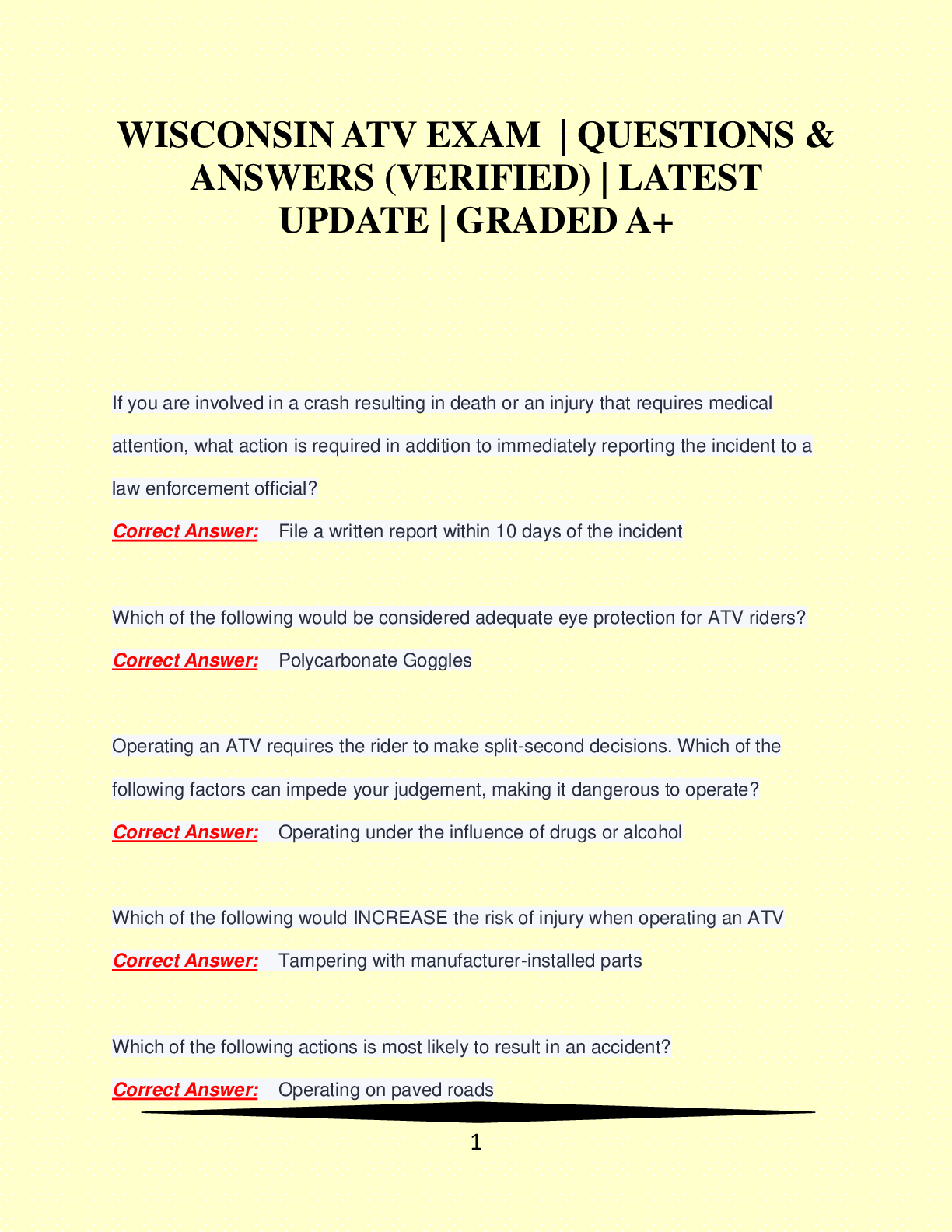
WISCONSIN CITIZENSHIP EXAM QUESTIONS & ANSWERS VERIFIED LATEST UPDATE
Surgery > QUESTIONS & ANSWERS > Surgery Week Quiz Series - Part 5 [GRADED A+] (All)
surgery week 5 quiz Q # 1 of 37 - 1 Points USMLE Step 2 CK Medical Subject Review 1. A 45-year-old woman has a past history that includes the fracture of both femur bones in a car accident 6 month ... s ago. She presents in the emergency department with frank hematuria that started suddenly the day prior to presentation. It is painless, and it is not associated with loin or abdominal pain. The patient reports taking warfarin that was prescribed for her 1 month ago; she had developed deep vein thrombosis (DVT). On examination, the patient is pale, anxious, and has cold extremities. Her blood pressure is 100/70 mm Hg, and her pulse is 100 beat/minute. Her cardiac examination reveals accentuated heart sounds, no added sounds, and no murmurs. What is the most important lab investigation at this time? A. Complete blood picture (CBC) B. International normalized ratio (INR) C. Plain pelvic X-ray D. Intravascular pyelography (IVP) E. Abdominal ultrasound 2. A 56-year-old man with a past medical history of diabetes mellitus type II, hypertension, myocardial infarction 1 year ago, and a 50-pack/year smoking history presents with unilateral leg edema and leg pain for the last 6 hours. His physical exam is remarkable for an elevated systolic blood pressure, obesity, and localized left lower extremity edema, erythema, and tenderness to the left lateral calf. What additional physical exam finding would be most consistent with a diagnosis of superficial thrombophlebitis in this patient? A. Linear induration along the course of a vein B. Peripheral cyanosis C. A positive Homan’s sign D. Reduced amplitudes of the dorsalis pedis and tibialis anterior pulses E. A shallow, well-circumscribed ulcer above the medial malleolus 3. An 84-year-old man with poorly controlled hypertension is evaluated for severe chest pain that came on suddenly; the pain is accompanied by an episode of syncope. The chest pain is described as “ripping”, and it radiates to the abdomen and back. There is no known history of trauma, injuries or accidents; he denies any fever, chills, cough, dyspnea, palpitations, nausea, vomiting or diarrhea. The physical exam is notable for tachycardia, a blood pressure of 188/120 mm Hg, and a high-pitched blowing decrescendo murmur at the right 2nd interspace. What agent is the preferred initial treatment in the management of this patient? A. Nitroprusside B. Diltiazem C. Morphine sulfate D. Enalapril E. Labetalol? 4. A 72-year-old woman goes to the Emergency Department with a 1-day history of severe abdominal pain and black stools. Her past medical history is significant for diabetes and hypertension. On physical exam, she was found to have extreme, diffuse abdominal tenderness. Signifcant laboratory findings included an elevated white blood cell count of 20,000 cells/cmm and a positive fecal occult blood test. All other examination and laboratory findings were within normal limits. An abdominal radiograph and CT performed on admission appeared normal. What is the most likely cause of this patient's symptoms? A. Mesenteric ischemia B. Abdominal aneurysm C. Small bowel obstruction D. Acute appendicitis E. Acute pancreatitis 5. A 40-year-old morbidly obese woman presents with Stage 4 kidney disease as well as fatigue, but she denies depressive symptoms, infectious symptoms, anorexia, and sleep disturbance. You would like to order some blood work to evaluate her complaints. Venipuncture attempts are often unsuccessful in this patient's case. She had a left lower arm arteriovenous graft placed 6 weeks ago. It has a palpable and audible thrill, but no surrounding edema, erythema, or discharge. How should you initially pursue the laboratory evaluation of her fatigue? A. Graft cannulation for blood sample B. Internal jugular venipuncture C. External jugular venipuncture D. Femoral venipuncture E. Psychology evaluation 6. A 45-year-old woman presents with a 4-week history of malaise. Her serum creatinine is 3.8 mg/dL and urea nitrogen is 40 mg/dL. Her serum antinuclear antibody (ANA) is negative, but her cytoplasmic anti-nuclear cytoplasmic antibody (c-ANCA) is positive. She has had an episode of hemoptysis. A chest X-ray reveals a reticulonodular pattern of infiltrates. A lung biopsy reveals necrotizing granulomas with vasculitis. What is the most likely diagnosis? A. Wegener's granulomatosis B. Buerger's disease C. Polyarteritis nodosa D. Hypersensitivity angiitis E. Giant cell arteriitis [Show More]
Last updated: 2 years ago
Preview 1 out of 14 pages
![Preview image of Surgery Week Quiz Series - Part 5 [GRADED A+] document](https://browseimages.nyc3.digitaloceanspaces.com/paper-images/2023/May/08/OKb2npPM2023-05-08-03-316458ebb83936e.png)
Buy this document to get the full access instantly
Instant Download Access after purchase
Buy NowInstant download
We Accept:


Surgery week 10 quiz Q # 1 of 39- 1 Points USMLE Step 2 CK Board Preparation 1. A sexually active woman with multiple partners presents with a 2-day history of red swollen left knee. On examinatio...
By geeks4geeks 2 years ago
$35
10
Can't find what you want? Try our AI powered Search
Connected school, study & course
About the document
Uploaded On
May 08, 2023
Number of pages
14
Written in
All
This document has been written for:
Uploaded
May 08, 2023
Downloads
0
Views
113
Scholarfriends.com Online Platform by Browsegrades Inc. 651N South Broad St, Middletown DE. United States.
We're available through e-mail, Twitter, Facebook, and live chat.
FAQ
Questions? Leave a message!
Copyright © Scholarfriends · High quality services·